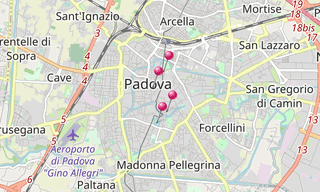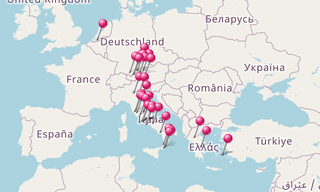Padua (Padova) is a city in the Veneto, northern Italy. Padua stands on the Bacchiglione River, 40 km west of Venice and 29 km south-east of Vicenza. It hosts the renowned University of Padua, almost 800 years old and famous, among other things, for having had Galileo Galilei among its lecturers. Padua is the setting for most of the action in Shakespeare’s The Taming of the Shrew.
Main sights
- The Scrovegni Chapel is Padua’s most famous sight. It houses a remarkable cycle of frescoes completed in 1305 by Giotto. It was commissioned by Enrico degli Scrovegni, a wealthy banker, as a private chapel once attached to his family’s palazzo. It is also called the “Arena Chapel” because it stands on the site of a Roman era arena. The fresco cycle details the life of the Virgin Mary and has been acknowledged by many to be one of the most important fresco cycles in the world.
- The Palazzo della Ragione, with its great hall on the upper floor, is reputed to have the largest roof unsupported by columns in Europe; the hall is nearly rectangular, its length 81.5 m, its breadth 27 m, and its height 24 m; the walls are covered with allegorical frescoes; the building stands upon arches, and the upper storey is surrounded by an open loggia, not unlike that which surrounds the basilica of Vicenza. The Palazzo was begun in 1172 and finished in 1219. In 1306, Fra Giovanni, an Augustinian friar, covered the whole with one roof. Originally there were three roofs, spanning the three chambers into which the hall was at first divided; the internal partition walls remained till the fire of 1420, when the Venetian architects who undertook the restoration removed them, throwing all three spaces into one and forming the present great hall, the Salone. The new space was frescoed by Nicolo Miretto and Stefano da Ferrara, working from 1425 to 1440. Beneath the great hall, there is a centuries-old market.
- In the Piazza dei Signori is the beautiful loggia called the Gran Guardia, (1493 - 1526), and close by is the Palazzo del Capitaniato, the residence of the Venetian governors, with its great door, the work of Giovanni Maria Falconetto, the Veronese architect-sculptor who introduced Renaissance architecture to Padua and who completed the door in 1532. Falconetto was the architect of Alvise Cornaro’s garden loggia, (Loggia Cornaro), the first fully Renaissance building in Padua. Nearby, the Cathedral, remodelled in 1552 after a design of Michelangelo. It contains works by Nicolo Semitecolo, Francesco Bassano and Giorgio Schiavone. The nearby Baptistry, consecrated in 1281, houses the most important frescoes cycle by Giusto de Menabuoi.
- The most famous of the Paduan churches is the Basilica di Sant’Antonio da Padova, locally simply known as “Il Santo”. The bones of the saint rest in a chapel richly ornamented with carved marbles, the work of various artists, among them Sansovino and Falconetto. The basilica was begun about the year 1230 and completed in the following century. Tradition says that the building was designed by Nicola Pisano. It is covered by seven cupolas, two of them pyramidal.
- One of the best known symbols of Padua is the Prato della Valle, a 90,000 m² elliptical square. This is believed to be the biggest in Europe, after Place des Quinconces in Bordeaux. In the centre is a wide garden surrounded by a ditch, which is lined by 78 statues portraying famous citizens. It was created by Andrea Memmo in the late 18th century.
- The abbey and the basilica of Santa Giustina. In the 15th century, it became one of the most important monasteries in the area, until it was suppressed by Napoleon in 1810. In 1919 it was reopened. The tombs of several saints are housed in the interior, including those of Justine, St Prosdocimus, St Maximus, St Urius, St Felicita, St Julianus, as well as relics of the Apostle St Matthias and the Evangelist St Luke. This is home to some art, including the Martyrdom of St Justine by Paolo Veronese. The complex was founded in the 5th century on the tomb of the namesake saint, Justine of Padua.
- The Church of the Eremitani is an Augustinian church of the 13th century, containing the tombs of Jacopo (1324) and Ubertinello (1345) da Carrara, lords of Padua, and for the chapel of SS James and Christopher, formerly illustrated by Mantegna’s frescoes.
- Santa Sofia is probably Padova’s most ancient church. The crypt was begun in the late 10th century by Venetian craftsmen. It has a basilica plan with Romanesque-Gothic interior and Byzantine elements. The apse was built in the 12th century. The edifice appears to be tilting slightly due to the soft terrain.

-Palazzo-della-Ragione.hero.landscape.jpg)

-Chiesa-degli-Eremitani.jpg?w=256)
-Chiesa-degli-Eremitani.jpg?w=256)
-Palazzo-della-Ragione.jpg?w=256)
-Palazzo-della-Ragione.jpg?w=256)
-Chiesa-degli-Eremitani.jpg?w=256)
-Chiesa-degli-Eremitani.jpg?w=256)
-Basilica-di-Sant%E2%80%99Antonio-da-Padova.jpg?w=256)
-Palazzo-della-Ragione.jpg?w=256)
-Chiesa-degli-Eremitani.jpg?w=256)
-Palazzo-della-Ragione.jpg?w=256)
-Palazzo-della-Ragione.jpg?w=256)
-Chiesa-degli-Eremitani.jpg?w=256)
-Chiesa-degli-Eremitani.jpg?w=256)
-Palazzo-della-Ragione.jpg?w=256)
-Palazzo-della-Ragione.jpg?w=256)
-Prato-della-Valle.jpg?w=256)
-Chiesa-degli-Eremitani.jpg?w=256)
-Prato-della-Valle.jpg?w=256)
-Palazzo-della-Ragione.jpg?w=256)
-Chiesa-degli-Eremitani.jpg?w=256)
-Basilica-di-Sant%E2%80%99Antonio-da-Padova.jpg?w=256)
-Palazzo-della-Ragione.jpg?w=256)
-Basilica-di-Sant%E2%80%99Antonio-da-Padova.jpg?w=256)
-Prato-della-Valle.jpg?w=256)
.jpg?w=256)
-Palazzo-della-Ragione.jpg?w=256)
-Basilica-di-Sant%E2%80%99Antonio-da-Padova.jpg?w=256)
-Basilica-di-Sant%E2%80%99Antonio-da-Padova.jpg?w=256)
-Chiesa-degli-Eremitani.jpg?w=256)
-Palazzo-della-Ragione.jpg?w=256)
-Basilica-di-Sant%E2%80%99Antonio-da-Padova.jpg?w=256)
-Basilica-di-Sant%E2%80%99Antonio-da-Padova.jpg?w=256)
-Prato-della-Valle.jpg?w=256)
-Basilica-di-Sant%E2%80%99Antonio-da-Padova.jpg?w=256)
-Chiesa-degli-Eremitani.jpg?w=256)
-Palazzo-della-Ragione.jpg?w=256)
-Basilica-di-Sant%E2%80%99Antonio-da-Padova.jpg?w=256)
-Chiesa-degli-Eremitani.jpg?w=256)
.jpg?w=256)
-Chiesa-degli-Eremitani.jpg?w=256)
-Palazzo-della-Ragione.jpg?w=256)
-Chiesa-degli-Eremitani.jpg?w=256)
-Basilica-di-Sant%E2%80%99Antonio-da-Padova.jpg?w=256)
-Basilica-di-Sant%E2%80%99Antonio-da-Padova.jpg?w=256)
-Chiesa-degli-Eremitani.jpg?w=256)
-Palazzo-della-Ragione.jpg?w=256)
-Palazzo-della-Ragione.jpg?w=256)
-Palazzo-della-Ragione.jpg?w=256)
.hero.jpg?w=320)

.hero.jpg?w=320)

.hero.jpg?w=320)

.hero.jpg?w=320)
.map.png)
-Palazzo-della-Ragione.jpg?w=256)
-Palazzo-della-Ragione.jpg?w=256)
-Chiesa-degli-Eremitani.jpg?w=256)
-Chiesa-degli-Eremitani.jpg?w=256)
-Palazzo-della-Ragione.jpg?w=256)
-Palazzo-della-Ragione.jpg?w=256)
-Chiesa-degli-Eremitani.jpg?w=256)
-Palazzo-della-Ragione.jpg?w=256)
-Prato-della-Valle.jpg?w=256)
.jpg?w=256)
-Basilica-di-Sant%E2%80%99Antonio-da-Padova.jpg?w=256)
-Palazzo-della-Ragione.jpg?w=256)
-Battistero-del-Duomo.jpg?w=256)
.jpg?w=256)
-Palazzo-della-Ragione.jpg?w=256)
-Palazzo-della-Ragione.jpg?w=256)
-Palazzo-della-Ragione.jpg?w=256)
-Chiesa-degli-Eremitani.jpg?w=256)
-Chiesa-degli-Eremitani.jpg?w=256)
-Palazzo-della-Ragione.jpg?w=256)
-Chiesa-degli-Eremitani.jpg?w=256)
-Chiesa-degli-Eremitani.jpg?w=256)
-Chiesa-degli-Eremitani.jpg?w=256)
-Chiesa-degli-Eremitani.jpg?w=256)
-Palazzo-della-Ragione.jpg?w=256)
-Palazzo-della-Ragione.jpg?w=256)
-Palazzo-della-Ragione.jpg?w=256)
-Palazzo-della-Ragione.jpg?w=256)
-Chiesa-degli-Eremitani.jpg?w=256)
-Chiesa-degli-Eremitani.jpg?w=256)
-Palazzo-della-Ragione.jpg?w=256)
-Palazzo-della-Ragione.jpg?w=256)
-Palazzo-della-Ragione.jpg?w=256)
-Chiesa-degli-Eremitani.jpg?w=256)
-Palazzo-della-Ragione.jpg?w=256)
-Palazzo-della-Ragione.jpg?w=256)
-Basilica-di-Sant%E2%80%99Antonio-da-Padova.jpg?w=256)
-Basilica-di-Sant%E2%80%99Antonio-da-Padova.jpg?w=256)
-Chiesa-degli-Eremitani.jpg?w=256)
-Chiesa-degli-Eremitani.jpg?w=256)
-Chiesa-degli-Eremitani.jpg?w=256)
-Palazzo-della-Ragione.jpg?w=256)
-Chiesa-degli-Eremitani.jpg?w=256)
-Palazzo-della-Ragione.jpg?w=256)
-Palazzo-della-Ragione.jpg?w=256)
-Palazzo-della-Ragione.jpg?w=256)
-Chiesa-degli-Eremitani.jpg?w=256)
-Chiesa-degli-Eremitani.jpg?w=256)
-Prato-della-Valle.jpg?w=256)
-Palazzo-della-Ragione.jpg?w=256)
-Palazzo-della-Ragione.jpg?w=256)
-Chiesa-degli-Eremitani.jpg?w=256)
-Battistero-del-Duomo.jpg?w=256)
-Prato-della-Valle.jpg?w=256)
-Chiesa-degli-Eremitani.jpg?w=256)
-Chiesa-degli-Eremitani.jpg?w=256)
-Chiesa-degli-Eremitani.jpg?w=256)
-Palazzo-della-Ragione.jpg?w=256)
-Basilica-di-Sant%E2%80%99Antonio-da-Padova.jpg?w=256)
.jpg?w=256)
-Chiesa-degli-Eremitani.jpg?w=256)
-Chiesa-degli-Eremitani.jpg?w=256)
-Chiesa-degli-Eremitani.jpg?w=256)
-Basilica-di-Sant%E2%80%99Antonio-da-Padova.jpg?w=256)
.jpg?w=256)
-Palazzo-della-Ragione.jpg?w=256)
-Palazzo-della-Ragione.jpg?w=256)
-Palazzo-della-Ragione.jpg?w=256)
-Chiesa-degli-Eremitani.jpg?w=256)
-Palazzo-della-Ragione.jpg?w=256)
-Palazzo-della-Ragione.jpg?w=256)
-Palazzo-della-Ragione.jpg?w=256)
-Palazzo-della-Ragione.jpg?w=256)
-Prato-della-Valle.jpg?w=256)
-Chiesa-degli-Eremitani.jpg?w=256)
-Chiesa-degli-Eremitani.jpg?w=256)
-Palazzo-della-Ragione.jpg?w=256)
-Palazzo-della-Ragione.jpg?w=256)
-Chiesa-degli-Eremitani.jpg?w=256)
-Chiesa-degli-Eremitani.jpg?w=256)
-Chiesa-degli-Eremitani.jpg?w=256)
-Basilica-di-Sant%E2%80%99Antonio-da-Padova.jpg?w=256)
-Battistero-del-Duomo.jpg?w=256)
-Chiesa-degli-Eremitani.jpg?w=256)
-Chiesa-degli-Eremitani.jpg?w=256)
-Chiesa-degli-Eremitani.jpg?w=256)
-Palazzo-della-Ragione.jpg?w=256)
-Basilica-di-Sant%E2%80%99Antonio-da-Padova.jpg?w=256)
-Basilica-di-Sant%E2%80%99Antonio-da-Padova.jpg?w=256)
-Palazzo-della-Ragione.jpg?w=256)
-Palazzo-della-Ragione.jpg?w=256)
-Palazzo-della-Ragione.jpg?w=256)
-Palazzo-della-Ragione.jpg?w=256)
-Palazzo-della-Ragione.jpg?w=256)
-Chiesa-degli-Eremitani.jpg?w=256)
-Chiesa-degli-Eremitani.jpg?w=256)
-Palazzo-della-Ragione.jpg?w=256)
-Chiesa-degli-Eremitani.jpg?w=256)
-Chiesa-degli-Eremitani.jpg?w=256)
-Palazzo-della-Ragione.jpg?w=256)
-Chiesa-degli-Eremitani.jpg?w=256)